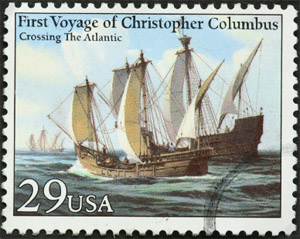Poetry Lesson Plan ("Columbus")
Poetry Lesson Plan ("Columbus")
- Home
- Poetry Lesson Plan
As a teacher, I had a difficult time finding poetry lesson plans.
Use this lesson plan for the poem "Columbus" by Joaquin Miller, and follow this step by step guide for teaching kids poetry.

Poetry Lesson Plan For "Columbus"
1. Before you read the poem aloud
Sometimes, it's helpful to set the stage for a poem. This is especially true if the poem is written from a perspective that children aren't familiar with.
"Columbus" is written about a time before airplanes, cell phones, and GPS systems. There were no cars, trucks, or highways. At the time that this poem takes place, people did not know the geography of the world. They did not know how much ocean or land lay between Europe and Asia.
The men in this poem are sailing their 15th century ship through unknown waters hoping to discover new land.
Imagine how scary it would be to set sail without knowing where you were going or what was out there! Many people during this time believed that there were monsters in the ocean waiting to attack them. The men in this poem sailed through storms and fog not knowing what they would find or how long it would be until they reached land.
Setting sail as an explorer must have taken a lot of courage and determination!
P.S. The admiral in the poem is Columbus.
2. Read the poem aloud to your students.
You may want them to follow along with a copy while you read, or you may want them to only focus on your reading. You may choose.
3. Identify and define words that students do not know.
At this point, hand out the poems and charts to students (You can make your own charts using the step-by-step guide linked to above, or you can get my version here. Mine includes a chart with definitions of some troublesome words, and I would encourage you to have students copy the definitions on their poem sheets.)4. Read the poem aloud again now that the students are familiar with the vocabulary.
Ask them to focus on the difference between the admiral and the mate and crew. What do the mate and crew want? Why? What does the admiral tell them?
5. Have students tell you in their own words what each stanza means.
You may have to help “translate” this poem for your students. I've included a chart with a section titled, “In Other Words” in the downloadable version of the lesson plan. Feel free to use it as your guide. Again, I would recommend that students write this information in their charts.6. Discuss the poem.
Here are eight key questions that you can use for this poem.
- 1. Why are the mate and crew scared?
They fear that the ship is lost and headed into unknown waters.
2. What do the mate and crew want?
They want to sail back home! They know what the seas are like on the way home. Since they know the geography of the coastlines of Europe, they would not be scared of the unknown.
3. What does the admiral tell them?
He does not show any emotion and simply tells the crew to continue sailing through the unknown waters.
4. Choose one word to describe the admiral.
brave, courageous, persistent, determined...
5. Why did you choose that word? (Use quotes from the poem.)
6. Choose one word to describe the mate and crew.
scared, timid, nervous...
7. Why did you choose that word? (Use quotes from the poem.)
8. Ask students for personal experiences and make connections to other areas of curriculum.
Does the admiral remind you of any characters from books or movies? Why?
Do the mate and crew remind you of any characters from books or movies? Why?
7. Assign the poem for students to memorize.
Break the poem into manageable chunks for your students - maybe they have three days to memorize each of the stanzas - you can decide!
It is really helpful for the students to recite it as a class a few times throughout the day.
8. Students recite the poem.
Students can recite each section as it is due and the whole poem at the end of your unit.
Download the Complete Lesson Plan
If you'd like this lesson plan along with a copy of the poem, the vocabulary chart, and the "translation," you can get it here! You won't have to do any prep. Just follow this lesson plan!
- 9 pages
- PDF download (You can print it off in minutes!)
- It contains all of the information on this page.
- It also contains a copy of the actual poem.
- It contains a chart with vocabulary words and a current "translation" of the poem for teachers.
- It contains a blank chart for your students. They can fill in the information as you go through it.
- Only $2.99

Sentence Diagramming Is Fun

Sentence diagrams show us how words, phrases, and clauses are all related. They also look really neat!
"Following the light of the sun, we left the Old World."
- Christopher Columbus
If you'd like to teach or learn grammar the easy way—with sentence diagrams—check out our Get Smart Grammar Program.
It starts from the very beginning and teaches you grammar and sentence diagramming in easy, bite-size lessons.

Hello! I'm Elizabeth O'Brien, and my goal is to get you jazzed about grammar.
This is original content from https://www.english-grammar-revolution.com/poetry-lesson-plans.html
Our Free Guide Gives You A Fun Way
To Teach And Learn The Basics v

Elizabeth O'Brien is the creator of Grammar Revolution.
Her lessons are guaranteed to give you more confidence in your communication skills and make you smile. :)

